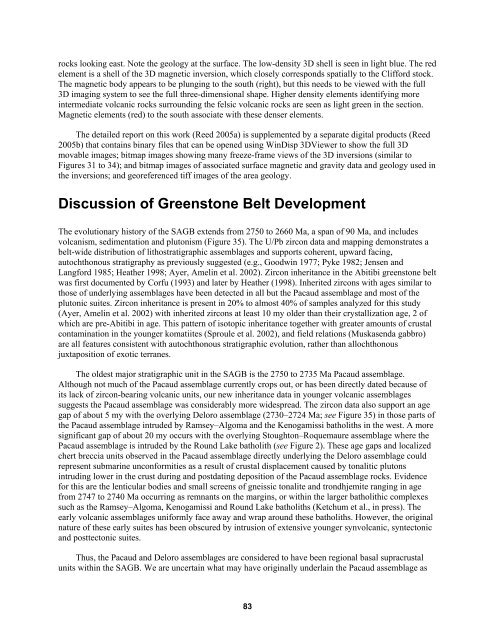Overview of Results from the Greenstone ... - Geology Ontario
Overview of Results from the Greenstone ... - Geology Ontario
Overview of Results from the Greenstone ... - Geology Ontario
Create successful ePaper yourself
Turn your PDF publications into a flip-book with our unique Google optimized e-Paper software.
ocks looking east. Note <strong>the</strong> geology at <strong>the</strong> surface. The low-density 3D shell is seen in light blue. The red<br />
element is a shell <strong>of</strong> <strong>the</strong> 3D magnetic inversion, which closely corresponds spatially to <strong>the</strong> Clifford stock.<br />
The magnetic body appears to be plunging to <strong>the</strong> south (right), but this needs to be viewed with <strong>the</strong> full<br />
3D imaging system to see <strong>the</strong> full three-dimensional shape. Higher density elements identifying more<br />
intermediate volcanic rocks surrounding <strong>the</strong> felsic volcanic rocks are seen as light green in <strong>the</strong> section.<br />
Magnetic elements (red) to <strong>the</strong> south associate with <strong>the</strong>se denser elements.<br />
The detailed report on this work (Reed 2005a) is supplemented by a separate digital products (Reed<br />
2005b) that contains binary files that can be opened using WinDisp 3DViewer to show <strong>the</strong> full 3D<br />
movable images; bitmap images showing many freeze-frame views <strong>of</strong> <strong>the</strong> 3D inversions (similar to<br />
Figures 31 to 34); and bitmap images <strong>of</strong> associated surface magnetic and gravity data and geology used in<br />
<strong>the</strong> inversions; and georeferenced tiff images <strong>of</strong> <strong>the</strong> area geology.<br />
Discussion <strong>of</strong> <strong>Greenstone</strong> Belt Development<br />
The evolutionary history <strong>of</strong> <strong>the</strong> SAGB extends <strong>from</strong> 2750 to 2660 Ma, a span <strong>of</strong> 90 Ma, and includes<br />
volcanism, sedimentation and plutonism (Figure 35). The U/Pb zircon data and mapping demonstrates a<br />
belt-wide distribution <strong>of</strong> lithostratigraphic assemblages and supports coherent, upward facing,<br />
autochthonous stratigraphy as previously suggested (e.g., Goodwin 1977; Pyke 1982; Jensen and<br />
Langford 1985; Hea<strong>the</strong>r 1998; Ayer, Amelin et al. 2002). Zircon inheritance in <strong>the</strong> Abitibi greenstone belt<br />
was first documented by Corfu (1993) and later by Hea<strong>the</strong>r (1998). Inherited zircons with ages similar to<br />
those <strong>of</strong> underlying assemblages have been detected in all but <strong>the</strong> Pacaud assemblage and most <strong>of</strong> <strong>the</strong><br />
plutonic suites. Zircon inheritance is present in 20% to almost 40% <strong>of</strong> samples analyzed for this study<br />
(Ayer, Amelin et al. 2002) with inherited zircons at least 10 my older than <strong>the</strong>ir crystallization age, 2 <strong>of</strong><br />
which are pre-Abitibi in age. This pattern <strong>of</strong> isotopic inheritance toge<strong>the</strong>r with greater amounts <strong>of</strong> crustal<br />
contamination in <strong>the</strong> younger komatiites (Sproule et al. 2002), and field relations (Muskasenda gabbro)<br />
are all features consistent with autochthonous stratigraphic evolution, ra<strong>the</strong>r than allochthonous<br />
juxtaposition <strong>of</strong> exotic terranes.<br />
The oldest major stratigraphic unit in <strong>the</strong> SAGB is <strong>the</strong> 2750 to 2735 Ma Pacaud assemblage.<br />
Although not much <strong>of</strong> <strong>the</strong> Pacaud assemblage currently crops out, or has been directly dated because <strong>of</strong><br />
its lack <strong>of</strong> zircon-bearing volcanic units, our new inheritance data in younger volcanic assemblages<br />
suggests <strong>the</strong> Pacaud assemblage was considerably more widespread. The zircon data also support an age<br />
gap <strong>of</strong> about 5 my with <strong>the</strong> overlying Deloro assemblage (2730–2724 Ma; see Figure 35) in those parts <strong>of</strong><br />
<strong>the</strong> Pacaud assemblage intruded by Ramsey–Algoma and <strong>the</strong> Kenogamissi batholiths in <strong>the</strong> west. A more<br />
significant gap <strong>of</strong> about 20 my occurs with <strong>the</strong> overlying Stoughton–Roquemaure assemblage where <strong>the</strong><br />
Pacaud assemblage is intruded by <strong>the</strong> Round Lake batholith (see Figure 2). These age gaps and localized<br />
chert breccia units observed in <strong>the</strong> Pacaud assemblage directly underlying <strong>the</strong> Deloro assemblage could<br />
represent submarine unconformities as a result <strong>of</strong> crustal displacement caused by tonalitic plutons<br />
intruding lower in <strong>the</strong> crust during and postdating deposition <strong>of</strong> <strong>the</strong> Pacaud assemblage rocks. Evidence<br />
for this are <strong>the</strong> lenticular bodies and small screens <strong>of</strong> gneissic tonalite and trondhjemite ranging in age<br />
<strong>from</strong> 2747 to 2740 Ma occurring as remnants on <strong>the</strong> margins, or within <strong>the</strong> larger batholithic complexes<br />
such as <strong>the</strong> Ramsey–Algoma, Kenogamissi and Round Lake batholiths (Ketchum et al., in press). The<br />
early volcanic assemblages uniformly face away and wrap around <strong>the</strong>se batholiths. However, <strong>the</strong> original<br />
nature <strong>of</strong> <strong>the</strong>se early suites has been obscured by intrusion <strong>of</strong> extensive younger synvolcanic, syntectonic<br />
and posttectonic suites.<br />
Thus, <strong>the</strong> Pacaud and Deloro assemblages are considered to have been regional basal supracrustal<br />
units within <strong>the</strong> SAGB. We are uncertain what may have originally underlain <strong>the</strong> Pacaud assemblage as<br />
83

















